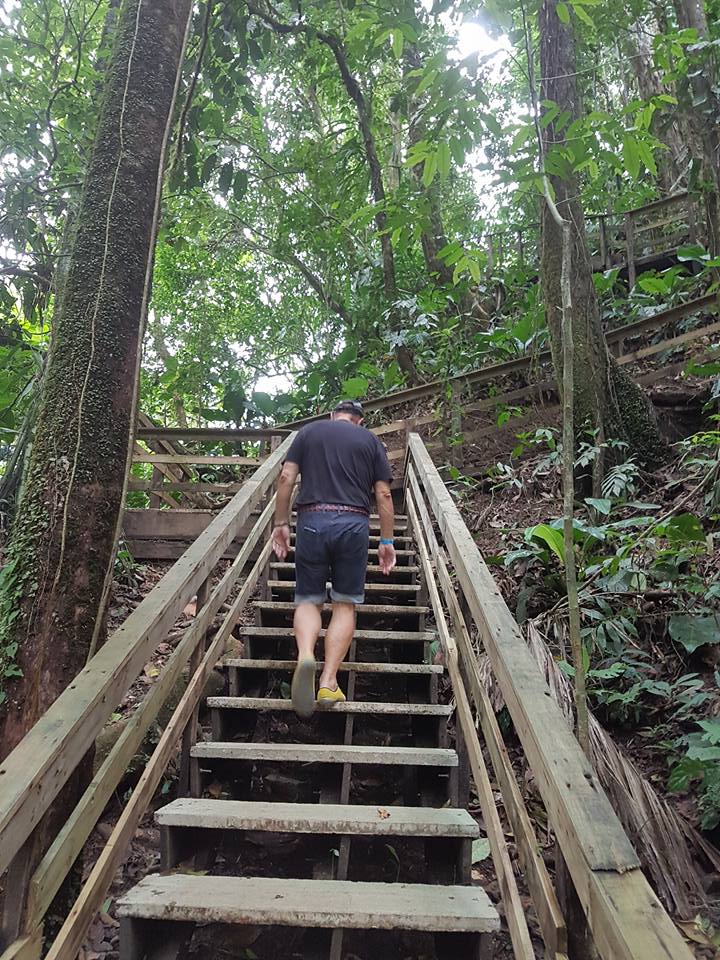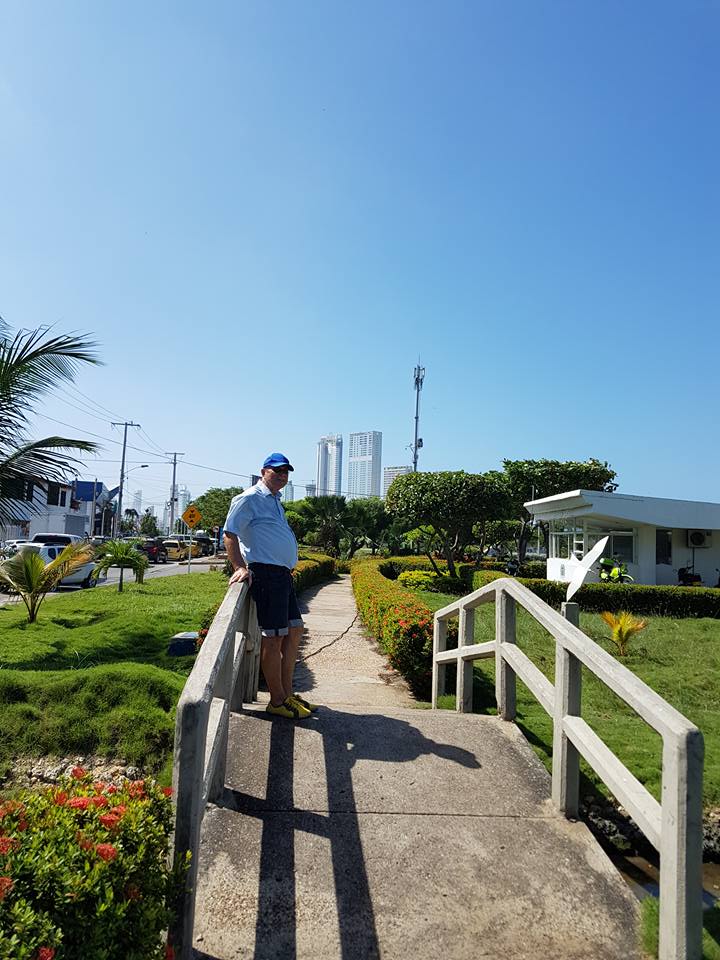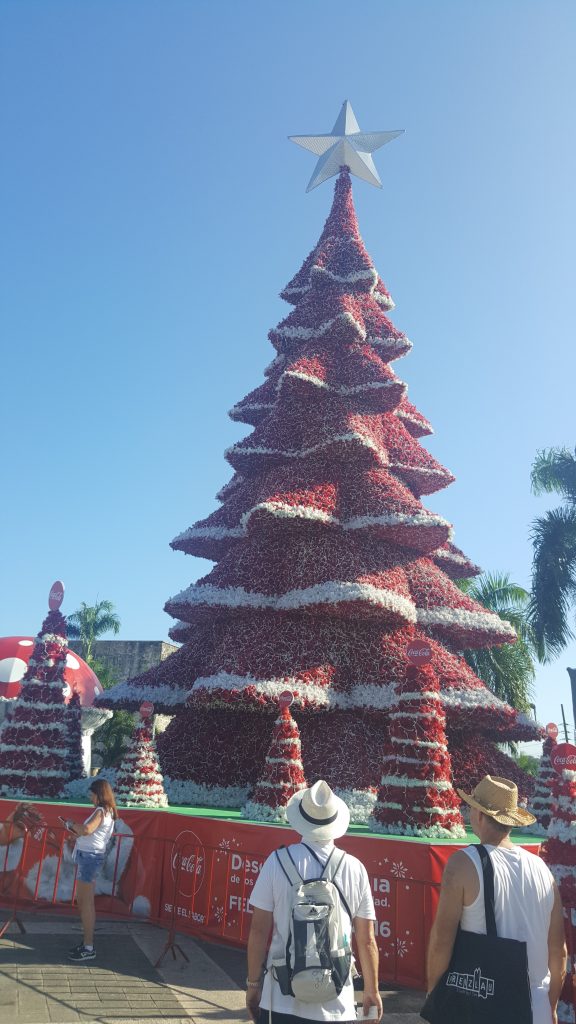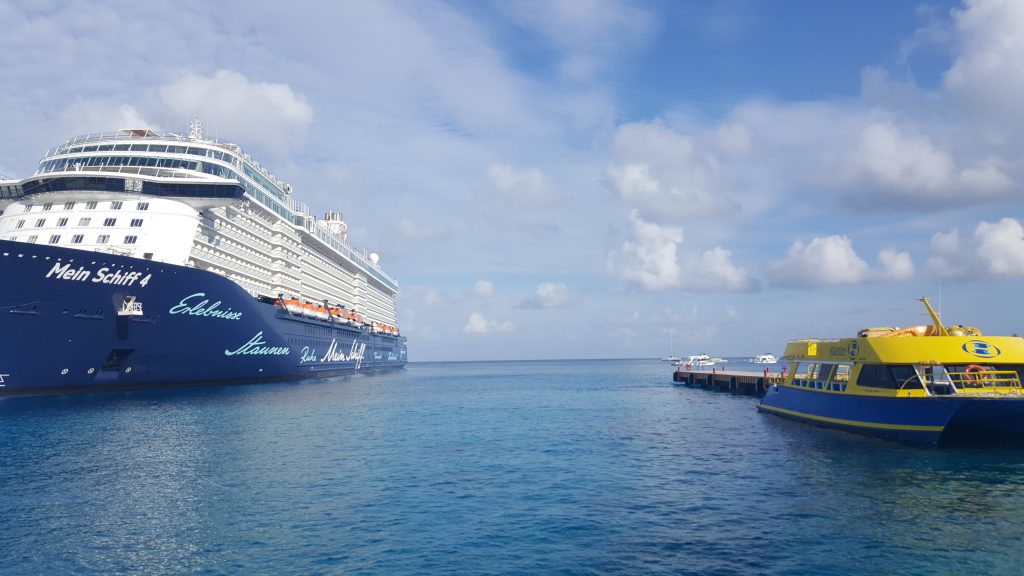In this article, I will tell you about the second week of our cruise through the northern Caribbean on the MeinSchiff 4. In an earlier IF Blog Post, I wrote about my adventures from the first week of this trip, between December, 9th and 16th. Those first seven days were over on December, 16th with our arrival at Roatán in Honduras. We had explored the area on our own and had taken a long and beautiful walk along the Westbays.
From Roatán, we started the second week in the evening with a day at sea on December, 17th. Puerto Limón in Costa Rica was our first destination.
December, 18th – Puerto Limón – Costa Rica – – BOAT, BUS, ON FOOT
Arrival time 7:00 /departure time 22:00; organized trip
Today is the fourth Advent Sunday and we arrived in the beautiful and warm Costa Rica. We booked a one-day trip.
The first leg is by boat to the Tortuguero Channels and then up to the Varagua Rainforest by bus. We are lucky, because our guide is from Germany and her name is Susanne. As a young girl, Susanne got stuck in Costa Rica in 1981, where she married a Costa Rican. Consequently, she has spent 35 intense years in this special country. And there are quite some stories she can tell.
Today, she is a grandmother and lives in Costa Rica with her family. It is her true pleasure and happiness to feed the hens with her grandchildren.
Apart from that, she is active in organizations that promote environment protection and trying to make tourism beneficial for the local population. And she works as a guide for ship tourists.
I said we were lucky because there were three groups doing the same tour. The second one was listed as English-speaking – which meant it was only for people who actually understood English. Unfortunately, however, the guide of that group hardly spoke any English (and, of course, no German). The third group was “German speaking”. However, their guide hardly spoke any German (and no English at all).
Bad news for nature …

The things Susanne told us about the Tortuguero Channels makes me rather sad. Costa Rica has a unique richness in species – perhaps due to its geographical position. Even from the boat, we can really appreciate it. You can see sloths with two or three toes, special water birds, crocodiles and much more, all of which we see at the riverbank. We admire the Mangrove Forests (Mangroven-Wälder) and understand how important they are for the eco system.
And then she tells us that this entire idyllic scenery will soon be no more, because at exactly this spot a new gigantic container terminal for the new and rather big industrial harbour will be built. And that the houses along the riverbanks are so dilapidated because the inhabitants have left the area a long time ago.
Apparently, the Costa Rican administration believes that such a gigantic infrastructure will be necessary in the future. Nobody really knows why. But that is irrelevant. And now, the big project will be realized after many years of protests, which means many hopes are shattered. It happens regardless of intense and international protest with many good arguments.
It was my general impression on this trip that most of the cranes in the harbours of Central America I saw seem to sleep an eternal “Big Sleep”. Even later, in Panama, which, as we know, is an important business and reloading point for merchandize, most of the cranes were idle.
But this seems how matters are on this world. Politics – pushed by lobbyists and industrial corporations – believe they can boost the local economy with huge infrastructure investments. And as soon as the things are built, they usually experience the great hang-over.
Intel produced many chips in Costa Rica. Now the Asians produce them. Who else? When all is said and done, countries such Costa Rica need tourism to survive. And tourism needs nature (incidentally, even in Panama, tourism does more for the economy than the cash cow Channel).
Regardless, the Costa Ricans are quite upbeat. They greet people with “Pura Vida“, which means something like “pure life”. Whenever people meet in Costa Rica, they tell each other “Pura Vida” and are happy. That is what I, too, will do in the future.
After the boat trip, we continue by bus to the Varagua rain forest. Even the trip by bus is an adventure. Through extremely bad and narrow streets with many sharp corners, the bus fights its extremely slow way up the hills. The bus driver exudes a serenity that is absolutely imperturbable. He gives no indication of impatience, regardless of the fact that, occasionally, this trip really makes you breathless.
As soon as we arrive at the top, our mood improves. Not only are we served a fair local meal, but it is also a beautiful place. The sheer nature experience of seeing the rainforest leaves us stunned.
We have a very diverse program. Night animals such as the red-eyed frog can be seen in a building where it is night in the daytime. There is a wonderful voliere for many colourful butterflies and a small zoo with all kinds of reptiles. We learn a lot about the colours of butterflies, the poison of frogs and snakes, life in the rain forest and much more.

One of the highlights of this tour is the presentation given by a young gentleman. He tells us what he as a scientist and his institute do to ensure the survival of, for instance, frog species that are threatening to die out. He explains his Spanish slides in Spanish. Susanne gives us excellent translations of what he says, just like all her explanations are always valuable and entertaining.
Another highlight is the way down into the valley by cable car that goes down steeply to the Puma waterfalls through the rain forest. Among other things, we see numerous monkeys doing gymnastics on the trees at eye-level with us. It is the “pura vida“ – even if it makes me a little thoughtful that we no longer can experience the beauty of the original rainforest with its gigantic trees. Instead, all we see is the secondary or tertiary rain forests. Because the huge tree giants of the original rain forest were removed by homo sapiens a long time ago through overexploitation.
As an alternative to this trip, we could have booked a journey with an old-timer train. That is also one of the things Costa Rica has to offer. Apparently, the railways were destroyed during the great earthquake in the early 1990ies. The company that did the calculations about whether or not re-building would be profitable was the biggest coach owner in Costa Rica. Consequently, the only small stretch that was rebuilt for tourist purposes was in Puerto Limón. The rest was abandoned.
December, 19th – Colón – Panama – – BUS, BOAT
Departure time 7:00 /arrival time 17:00; organized trip;
Taking nine hours, the journey from Puerto Limón to Colón was on the short side. And we had booked another organized trip in Colón. After all, Barbara and yours truly wanted to be on the Pacific Ocean again – even if only for a short time – and see the skyline of Panama City. More than anything, we also wanted the experience of sailing on a segment of the Panama Channel.
Apparently, we were not the only ones who wanted that. The trip was rather overbooked. Sixteen busses were waiting in front of our ship exclusively for the ship passengers. The passengers were assigned to busses in an almost military-style way in the ship theatre. Everybody wants to ride on the Panama Channel (or at least on some of it). And, as I see it, the trip was well worth the money.
From Colón it is about one hour’s drive to Gamboa. We have a wonderful guide. She exudes pure life. To be sure, her English is a little limited, but you can easily understand what she says. Her presentation is great, once in a while she even shows considerable cabaret talent. It is a true pleasure to listen to her and time flies during the bus ride.
We pass Manuel Noriega’s jail. To me, the building looks like something between a castle and a stronghold. Gamboa is almost exactly the midway point of the 82 kilometres of length that the Panama Channel measures between the Atlantic and Pacific Oceans. In Gamboa, we were transferred to two huge ferries (at least they are considerably bigger than the tour boats we were used to). They are to bring us to the Pacific Ocean. These are simple ships with open decks on two levels. Since the day is warm and the ships are rather crowded, the seats under the shadow are very sought after and quickly become a rare luxury.
Unfortunately, the guide on the ship is nowhere near as good as the guide on the bus was. The loudspeakers have been set too loud and the journey is rather tedious. They cannot exactly predict how long the ride will take, because it depends on the traffic. If a water giant comes along, she will be given right of way. After all, these huge ships also pay enormous amounts of money for the transfer. For the really huge ships that, due to recent construction projects, can now also pass on this part of the way, the toll fee is allegedly up to one million USD.
The duration is an estimated four to five hours. Passing the water-gates on the way to Panama City, even though they allow us to overcome a difference in altitude of around thirty metres, does not really fascinate us. After all, we are quite experienced with the house boat and consequently know about water-gates. Besides, we have often experienced the quiet Rhein-Main-Donau Channel and, a short time ago, we visited the Oder Ship’s Lift during our bike tour from Penemünde to Berlin. Consequently, the sluices are less impressive in our eyes than the artificially created lake scenery.
The narrowest part of the channel, the Gaillard Cut, is part of our way. The two peaks – at least one of them has been cut – are really worth seeing. Near the sluices, we pass rather crowded channel observation points. There is plenty of activity.
As we are on the way into the Miraflores Lake there is an announcement that comes as rather a surprise: today, passing the channel was very quick and we will be at our destination in 45 minutes. That would mean only 3.5 hours total traveling time. But before we pass the Puente de las Américas the channel administration stops our ferry.
We have to wait for a gigantic container ship. We wait almost two hours for her to pass, then we continue on our way. This is how, eventually, the trip is almost five hours, after all.
As we exit the Miraflores Lake we are on the Pacific Ocean until we come to Balboa, which is the most remote of a small series of islands that are connected with the mainland through a dam. We are standing at the stern and see the Puente de las Américas get smaller and smaller. On the larboard side, the silhouette of Panama City slides past. It is all rather impressive.
In Balbao we leave our ferry and again board our bus. Our super guide is there to welcome us and makes the time on board the bus pass quickly. The bus runs on the motorway all the way from the Pacific Ocean to the Atlantic Ocean until we are back at the ship – on time for our departure at 6 p.m. Said departure is particularly enjoyable, because at 18.00 hours local time you can still see quite a bit of Panama in the light of the setting sun.
December, 20th – Cartagena – Columbia – – ON FOOT / TAXI
Arrival time 9:00 /departure time 20:00; private tour;
The last two days were spent doing two one-day trips that actually were quite exhausting. Consequently, we want to be a little leisurely today and thus set out on our own.

With more than one million inhabitants, Cartagena is a truly huge city. The silhouette of the city contains many skyscrapers and is no less impressive than that of Panama City. However, there is also a comfortable old city – partly still enclosed in the original, well preserved city walls – that beckons with many museums and other attractions.
Our ship lies in the container harbour. The city map at the harbour information centre lets us conclude that the way to the old city is almost ten kilometres. However, the way looks pretty straightforward, so we start walking. And again, many taxi drivers try to tell us that the way is far too long on foot. By now, however, we have quite a bit of experience when it comes to resisting the calls of the sirens …
The traffic is dense on the two-lane one-way road. The pedestrian’s paths, too, are rather full. More often than not, we walk faster than the cars can drive. We feel relieved when we pass a bus with an “organized trip” from our MeinSchiff 4.
Many small yellow taxis are also stuck. In this country, they are considered public transportation. But there are also many public busses. I discover that quite a few of the yellow taxis are electronically powered. They are the KIA brand.
It is a very impressive hike to the old harbour. We pass the entrance and see a huge portal in the city wall. Here it is: the old city. It is rather tempting: there are museums, bars, pubs and shops.
We take a lot of time strolling around and window-shopping. Afterwards, we are really tired. So we want to go back to the ship to enjoy the time and look for a taxi. We quickly find it and later spend a wonderful late afternoon on board the ship.
Now our journey will soon come to an end. We have to go back from Columbia to the Dominican Republic. Our next to last destination before the return flight from La Romana is Santo Domingo. It is quite a way to go there, which is why we start our last day at sea, on December, 21st, at 8 p.m..
It is a wonderful exit. We can see the lights of Cartagena and Columbia for a long time and slowly take our leave from Central America. Even though we are no longer in Panama, I buy myself a Panama hat for the German and Greek summer of 2017.
Barbara also weakens and gets a wonderful lady’s hat – also for the hot summer of 2017. After short but determined haggling with the flying hat merchant, we get both hats for the total sum of 14 USD. At the airport, my hat is 20 USD – the ladies’ hats are a lot more expensive.
December. 22nd – Santo Domingo – Dominican Republic – – ON FOOT
Arrival time 8:00 /departure time 20:00; private tour;

The end of our journey nears. There is one full day on the Caribbean left, along with one night on board our ship – and then we go back, away from this warm weather. We want to arrive in Munich on Christmas Eve and then celebrate with our children and their partners.
Today, we take another walk. This time around, the way from the harbour to the city seems rather short. So this is our last stroll in Central America. Not at all far from where our ship lies, a swimming bridge spans the arm of the sea that leads to the harbour. And then we arrive.
Regardless of Santo Domingo being a huge city – with many people living around the city – it also has a really charming old city. It really invited us to do some strolling. It is not very extensive and has only flat buildings and a few parks.
In one of the parks, they are recording a film. Parts of the street are kept empty, which takes a huge effort by the filming crew. There is a lot to see for us. Again and again, we meet a group from our ship with the guide walking at the front and holding his sign over his head.
Bars and pubs with “free WLAN” can also be found. Consequently, we go and drink a coffee, at the same time giving our cell-phones some nourishment. The invoice comes in local currency and also in USD and EURO. What a small place the world has become!
Incidentally, the abbreviation for the Dominican Republic is R.D. – my initials. I see baseball caps, t-shirts and other products to remember the place by all over the place. They all carry my initials. Consequently, I succumb and buy an R.D. baseball cap. It will be a Christmas present for my son Rupert Dürre (another R.D.)
As for the rest of the day, we enjoy being together and look forward to Christmas.
December, 23rd – La Romana – Dominican Republic– – BOAT
Arrival time 8:00 / Transfer to the airport 14:45; organized trip;
This is our last day. A few days ago, we booked an organized trip for this morning. It is a boat trip including snorkelling and visiting the beach. It is scheduled to be finished at 2 p.m., which should give us enough time for the direct transfer to our plane.
We already packed yesterday evening. The luggage had to be in front of our doors by midnight and has already been picked up. I also added my backpack with the warm clothes. Consequently, we are all set and all we have to do at the airport is identify our luggage and then hand the two suitcases over at the check-in counter.
Again, the trip is well organized. Our boat is already waiting for us at the stern of MeinSchiff 4. We have a crew of three, a lady from Switzerland and two locals. Everybody is really in high spirits. On the way, we get cola, sprite … and lots of rum. Cuba libre! For food, they took Pastelitos, that is some kind of filled pastry.
Our first stop is for snorkelling, then we drive to the beach. The area with the blue reclining chairs is for us. It costs 2 USD to use the reclining chair, lying at the beach on your own towel and swimming in the ocean are included in the price. A “Costa“ cruiser is sitting on the beach and busily “tendering” guests to the mainland who apparently are mostly Italian. The place is as busy as the Munich Marienplatz
This is the day before Christmas Eve. It is all about eating, drinking, sunshine and enjoying the water, along with “being at leisure”. We particularly enjoy this last time of the tropic atmosphere on the ocean and go into the water more often than on the entire trip. Then the boat takes us back to the ship – adieu Caribbean!
The boat gets us back to the ship on time. On the 12th deck of MeinSchiff4, we eat our last hamburger at the grill bar and wash the remainders down with Corona. Then we go to our bus that takes us to the plane. After all, we want to celebrate Christmas at home under a green tree tomorrow.
At Christmas Eve, we are at the airport S-Bahn train platform at 8.30 a.m., waiting for the line 8 to Munich East. There is no problem with changing to line 7, all trains are on time. Around 10 a.m., we arrive in Neubiberg. My first activity is riding my bike to Butcher Schlammerl in Ottobrunn and buying some Weißwürste. Then I ride to Baker Schlank in Putzbrunn to buy Brezeln to go with them. Lunch is on – and – Christmas Eve can come!

This is all! I will write another article and give some advice on the cruise ship – and then I will get back to other topics.
For instance what is basically the system-theoretical problem in our society.
RMD
(Translated by EG)

